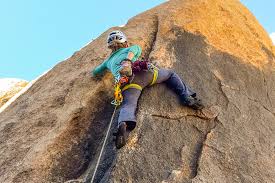Introduction
If you’ve mastered the art of top rope climbing and are ready to take your climbing skills to the next level, lead rock climbing is your ticket to thrilling vertical adventures. Lead climbing offers a sense of freedom and self-reliance, as you become the one in charge of setting your own protection. But before you venture into the vertical unknown, you’ll need the right gear to ensure your safety and success. In this comprehensive guide, we’ll equip you with the essential lead rock climbing gear to help you conquer new heights with confidence.
- Climbing Ropes – The Lifeline of Lead Climbers
Lead climbing requires dynamic ropes designed to stretch and absorb the impact of a fall. Look for ropes with a diameter between 9.8mm to 10.2mm, striking a balance between durability and weight. Choose a length suitable for the routes you plan to climb, ensuring you have enough rope for safe clipping and belaying.
- Webbing – Building a Solid Anchor System
Building reliable anchor systems is crucial in lead climbing. Webbing comes in various materials, such as nylon and dyneema, each offering distinct advantages. Nylon webbing is durable and abrasion-resistant, making it suitable for general anchor setups. Dyneema webbing, on the other hand, is lightweight and perfect for creating compact and lightweight anchor systems.
- Passive Protection – The Art of Placing Nuts and Cams
Lead climbers rely on passive protection devices like nuts and cams to secure themselves to the rock. Nuts, also known as stoppers, wedge into cracks and provide reliable anchors. Cams, on the other hand, are spring-loaded devices that expand and grip the rock when placed correctly. Learning to place and assess passive protection is a vital skill for lead climbers.
- Active Protection – Embrace the World of Spring-Loaded Devices
Active protection devices, such as spring-loaded camming devices (SLCDs), are mechanical devices that expand and grip the rock when placed. These versatile tools are essential for lead climbing, as they provide secure protection in a wide range of crack sizes.
- Climbing Shoes – The Foundation of Your Ascent
Your choice of climbing shoes can greatly impact your lead climbing performance. Look for shoes with a snug fit and an aggressive design to provide optimum precision and grip on small holds and edges. Climbing shoes with sticky rubber soles ensure you can confidently tackle even the most challenging routes.
- Carabiners – Connecting Your Gear with Confidence
Carabiners are the backbone of your climbing setup, connecting your ropes, harness, and protection devices. For lead climbing, invest in a mix of locking and non-locking carabiners. Locking carabiners provide added security when connecting crucial elements of your gear, such as your belay device or harness.
- Climbing Harnesses – Safety and Comfort at New Heights
A well-fitted climbing harness is essential for lead climbing, as it provides safety during falls and distributes your weight efficiently. Look for harnesses with adjustable leg loops and waist belts for a personalized fit. Ample padding ensures comfort during long climbs.
- Belay Devices – Control and Confidence
Belay devices are critical for belaying your climbing partner and controlling the rope during climbs and descents. Invest in an assisted braking device for smoother belaying and added security in case of a fall.
- Clothing – Climbing in Comfort
Dress for success in lead climbing with comfortable and flexible clothing. Opt for moisture-wicking, quick-drying fabrics to keep you dry during intense climbs. Consider wearing climbing-specific pants with articulated knees and a gusseted crotch for enhanced mobility. A moisture-wicking shirt and a lightweight jacket are essential for adapting to changing weather conditions.
Frequently Asked Questions – Your Lead Climbing Gear Queries Answered
- Can I use a top rope climbing rope for lead climbing?
Top rope climbing ropes are generally thicker and more durable, but they may not be as ideal for lead climbing due to their weight. For lead climbing, opt for a dynamic rope designed to stretch and absorb impact during falls, providing better safety.
- What’s the difference between passive and active protection?
Passive protection consists of non-mechanical devices like nuts and hexes that rely on their shape to wedge into cracks. Active protection devices, such as cams, are spring-loaded and expand to grip the rock when placed.
- How do I choose the right harness?
Choosing the right harness depends on your climbing style and fit preference. Look for harnesses with adjustable leg loops and waist belts for a personalized fit. Consider comfort and ample padding, especially for extended climbing sessions.
- Can I use any carabiner for lead climbing?
For lead climbing, it’s best to use climbing-specific carabiners designed to handle the demands of the sport. Invest in a mix of locking and non-locking carabiners to ensure versatility and safety.
Conclusion
Armed with the essential lead rock climbing gear, you’re now ready to ascend into a world of vertical adventure. Always prioritize safety, training, and gaining expertise in lead climbing techniques before you embark on challenging routes. So, gather your gear, lace up those climbing shoes, and prepare to conquer new heights with the electrifying sport of lead rock climbing! Happy climbing!
